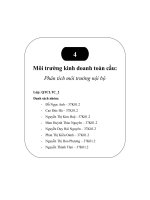Chiến lược giá sản phẩm Pricing Strategy
Bạn đang xem bản rút gọn của tài liệu. Xem và tải ngay bản đầy đủ của tài liệu tại đây (4.42 MB, 24 trang )
Pricing strategy
for start-up business
Outline
1. Pricing positioning
2. Pricing methods
3. Models pricing strategy for start-up business
Why do we need a strategy for pricing?
•
One of the toughest decisions for a startup is how to price their
product or service.
•
The implications of the decision you make are huge, defining your
brand image, your funding requirements, and your long-term
business viability.
•
The revenue model you select is basically the implementation of your
business strategy, and the key to attaining your financial objectives.
No one-size-fit-all
Learning how to price offers is one of the most challenging skills that an
entrepreneur has to learn on her journey. As much as you might want a
quick how-to to walk you through exactly how to price something
Pricing positioning
the Price
Pricing position & strategy
Pricing methods
Why do we need a strategy for pricing?
•
Obviously, it must be grounded by the characteristics of the
market and customers you choose to serve, the pricing model
of existing competitors, and a strategy you believe is consistent
with your future products and direction.
•
Your business model interacts closely with your marketing
model, but don’t get them confused. Marketing is initially
required to get visibility and access to the opportunity, but
pricing defines how you will actually make money over the
long term.
Pricing methods
1. Cost-based pricing
!Set your price as a multiple of
cost, or cost plus a determined
amount. An example would
be a book store selling each
book for 150 percent of
whatever amount the store
paid for it. Another example
is a clothing boutique selling
items for twice what it paid to
buy them.
Value-based pricing
Base your price on what your product
and service is worth to the buyer.
Computer software, for example, is
often priced according to the time-
savings and productivity gains, rather
than the direct cost. Some would say
airlines use a value basis to price the
same flight differently for different
travelers; they're cheaper for budget-
minded consumers who buy with a
lot of advance notice, and more
expensive for the business traveler
who has to go somewhere today.
Market-based pricing:
!Let the market determine the price. This is the most common and
most realistic pricing method for small and medium businesses. If
everybody else charges $15 for a haircut, you charge $15 for a
haircut, or some price related to $15 depending on your strategy.
Maybe you want to be a low-cost provider, for example, so you
charge less (which leads us to that very common pricing error).
model for start-up
Product or service is free, revenue from ads and critical mass
This is the most common model
touted by Internet startups today,
the so-called Facebook model,
where the service is free, and the
revenue comes from click-through
advertising. It’s great for
customers, but not for startups,
unless you have deep pockets. If
you have real guts, try the Twitter
model of no revenue, counting on
the critical mass value from
millions of customers
Product is free, but you pay for services
In this model, the product is given away for free and the customers
are charged for installation, customization, training or other services.
This is a good model for getting your foot in the door, but be aware
that this is basically a services business with the product as a
marketing cost.
“Freemium” model
In this variation on the free model, used by Viber, Zalo… and many other
Internet offerings, the basic services are free, but premium services are
available for an additional fee. This also requires a huge investment to get to
critical mass, and real work to differentiate and sell premium services to
users locked-in as free.
Cost-based model
In this more traditional product pricing model, the price is
set at two to five times the product cost. If your product is
a commodity, the margin may be as thin as ten percent. Use
it when your new technology gives you a tremendous cost
improvement. Skip it where there are many competitors.!
Ex: transportation, traveling, hand-made food…
Value model
If you can quantify a large value or cost savings to the
customer, charge a price commensurate with the value
delivered. This doesn’t work well with “nice to have”
offerings, like social networks, but does work for new
drugs that solve critical health problems.
Portfolio pricing
This model is relevant only if
you have multiple products
and services, each with a
different cost and utility. Here
your objective is to make
money with the portfolio,
some with high markups and
some with low, depending on
competition, lock-in, value
delivered, and loyal
customers. This one takes
expert management to work.
Competitive positioning
In heavily competitive environments,
the price has to be competitive, no
matter what the cost or volume. This
model is often a euphemism for
pricing low in certain areas to drive
competitors out, and high where
competition is low. Competing on
price alone is a good way to kill your
startup.
Razor blade model
In this model, like cheap printers
with expensive ink cartridges, the
base unit is often sold below cost,
with the anticipation of ongoing
revenue from expensive supplies.
This is another model that requires
deep pockets to start, so is normally
not an option for startups.
Now learn more ways to get your business off the ground
Thank you!









